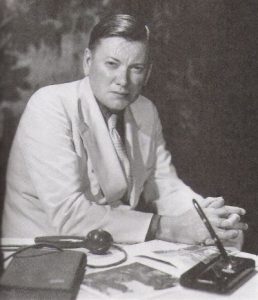7 Ralph Peer and Country Music
The phenomenal success of “Crazy Blues,” the first race record of the 1920s, ironically also gave rise to the genre we now call “country” music, the music of the white, rural south. The producer of the “Crazy Blues” recording was a young, white midwesterner, Ralph Peer. Working as a producer for Okeh records, Peer realized that blacks were not the only music consumers who longed for an opportunity to buy recordings of a style of music that reflected their own culture. White, rural, southerners also had a distinct musical style that up to the 1920s had gone unnoticed by the record industry. Okeh Records granted Peer the permission in 1923 to begin experimenting with this style by recording the winner of a local fiddle contest in Virginia, “Fiddlin’” John Carson. Given that the recording was only a solo instrumental, it caught even Peer by surprise when Carson’s screechy fiddle tune quickly sold out its initial pressing of 500 copies. Peer had, indeed, found another previously untapped market.

Peer quickly built on his initial success by setting up recording auditions in several southern cities, where no record studios existed. To do so, however, he had to jump ship to another record lablel, Victor, after Okeh was purchased by now-struggling Columbia Records in 1925. Working with Victor, a record company eager to diversify its music offerings, Peer set up a temporary studio in Bristol, Tennessee and advertised to musicians in the Appalachian hill country to come audition for recordings. These 1926 recording sessions in Bristol resulted in several of the seminal recordings of what was then called “hillbilly” or “old time” music, but would later be known as “country” music. Two artists in particular, singer Jimmie Rodgers and the Carter Family, made recordings for Peer in these sessions that would cement their places as the founding musicians of the genre.
Ralph Peer demonstrated he was not just a good record producer and talent scout, he also distinguished himself as a formidable businessman and entrepreneur. Realizing that the structure of the music industry was still built largely around song copyrights and publishing royalties, Peer insisted that his artists sign over their song copyrights to his newly-formed publishing company, Southern Music Company. Peer’s artists were paid a flat fee in the range of $25 to $50 dollars for their recordings, but the rights to the master recordings and the songs were retained by Victor and Peer’s publishing company, respectively. No doubt, performers such as Jimmie Rodgers were elated to earn $50 for recording a record, but they had little idea how much they were giving up by assigning away all rights to copyright royalties.
While stories such as these initially inspire empathy for the unfairness of such deals, we need to remember that, at the time, Peer and Victor had no reason to assume that any of these recordings would be commercially successful. The record industry is built on the assumption of risk by the recording company. While the company benefits disproportionately from any upside profits made by a recording, the company also bears the risk that the recording will not sell. The artist, meanwhile, bears no share of the risk – but also none (or little) of any potential profit. This risk/reward scenario becomes even more fraught with accusations of unfairness when the issue of race is added to the mix. The same sorts of one-sided contracts were routinely signed by black rural blues artists in the 20th century, with one-time fees paid to the performer, who received no back-end royalties (but also no assumption of the risk of failure). In cases where the performer’s recordings went on to some commercial success (a rarity in that time), the relationship seems unfair at best, and exploitative and racist at worst. Again, it’s important to remember that this relationship was standard for nearly all performers, black and white, in these emerging rural genres.
By the 1930s, after the commercial viability of both blues and country had been established, Ralph Peer updated his approach by offering his recording artists a 50% share in the copyrights to their songs, a business relationship that would come to define the modern publishing industry. Peer and his Southern Music publishing company essentially invented the business model of the performer and songwriter who earn money not only from the sale of their recordings but also through their copyrighted songs. Peer was typically only interested in recording artists who wrote their own songs so that both he and the artist would earn copyright royalties rather than having them go to an unaffiliated songwriter.

